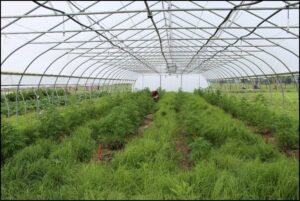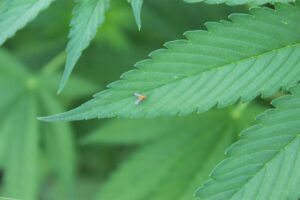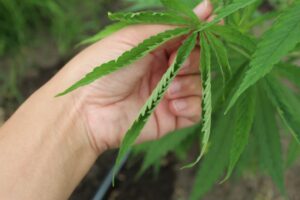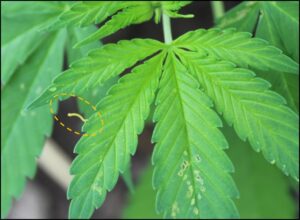This is our second year scouting CBD hemp to learn more about the insect communities occurring on these plants throughout the season and ‘who’ the potential pest insects might be! This year we had the opportunity to scout CBD hemp plants grown both in the field and in a high tunnel environment (Figure 1). Since insect communities, both pest and beneficial, can vary between indoor and outdoor production systems, we were excited to see if different kinds of insects occurred on hemp plants grown outdoors versus in high tunnels.
Insects visiting hemp plants
So far, we have observed many of the same kinds of insects on hemp grown outdoors and in the high tunnel. Some of the most common insect visitors we’ve observed on hemp this season are the flies, including fruit flies, the showy and often metallic long-legged flies (Figure 2), grass flies, house flies, and crane flies. The larval and adult stages of long-legged flies are beneficial insects that are known to attack soft-bodied arthropod pests, including mites, whiteflies, and aphids! However, we have not observed these predators attacking any insect pests so far. Other insect visitors to hemp included soldier beetles, japanese beetles, snout moths, fireflies, and even june beetles! Although several of these visitors are plant-feeding insects, none were observed feeding on hemp; rather, they appeared to be ‘taking a break’ on hemp plants.
Potential insect pests
Leafhoppers are one of the most common and abundant insects we’ve observed on both indoor and outdoor hemp this season. Don’t be surprised to see brown, green, or even pale, white-colored leafhoppers perched on the stems and leaves of hemp plants. Leafhoppers leave behind obvious symptoms of feeding damage, called ‘hopper burn’, on crops like strawberry, apple, beans, and alfalfa. The piercing-sucking feeding strategy these insects have causes leaf margins to curl upwards and inward toward leaf veins, and some leafhoppers even inject toxins into plants while feeding. Given the high number of leafhopper nymphs and adults (including potato leafhopper) we’ve observed on hemp this season, we suspect the leaf curling symptoms we’ve observed on CBD hemp to be the hemp plant’s version of ‘hopper burn’ (Figure 3), and this is the first year we’ve seen it!
Other potential pest insects we’ve observed feeding on CBD hemp this season include cannabis aphid, whiteflies, red-headed and other smaller flea beetles, and caterpillars belonging to the ‘leafroller’ and ‘inchworm’ moth families. Inchworm caterpillars may appear to be tiny branches sticking out from hemp leaves (Figure 4), and leafroller caterpillars often glue leaves together to form a protective shelter for themselves. If you see any of these signs, you may have one of these caterpillar visitors on your hemp!
Beneficial insects & arthropods
Predatory insects and arthropods often make our day out in the field! This season, we’ve seen lady beetle adults and larvae, minute pirate bugs, predatory thrips, praying mantids, crab, jumping, and wolf spiders, and several kinds of parasitoid wasps. These ‘good insects’ may be found on every part of the plant and have different hunting strategies. For example, spiders may actively hunt for prey or wait to ambush prey once they land on plants. Praying mantids rely on an ambush strategy, blending in with the plant and waiting for prey to arrive or pass by (Figure 5). Meanwhile, lady beetles are active hunters, searching plant surfaces for prey and mowing down large numbers of soft-bodied insects when they find them, including aphids and whitefly eggs and nymphs.
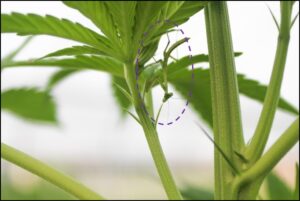
Figure 5. A well-camouflaged praying mantis, waiting for passing prey under a hemp leaf. Photo by E. Y. Long
We will continue our hemp scouting efforts through August and keep you posted on the insects we see! If you have pictures of insects you’d like to share with us from your hemp production systems, we welcome you to share them with us via our Purdue Fruit & Veg IPM Facebook page!
